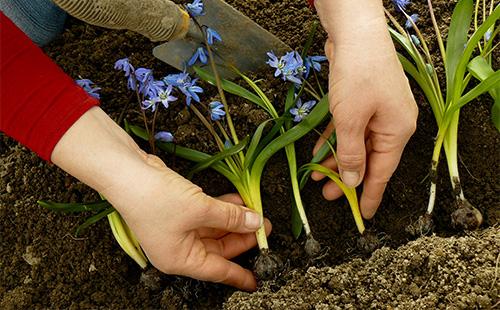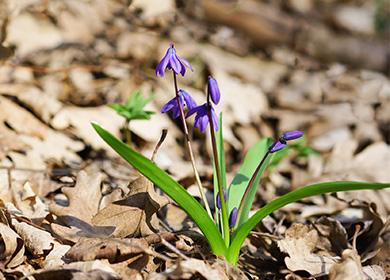The content of the article
Bluebells are a traditional early spring phenomenon. In nature, Scylla is a primrose and is actively used in decorative gardening. Such plants are not afraid of frost and are safely grown in open ground. But there are indoor varieties of Scylla, which are suitable only for home maintenance.
Botanical signs of a bluebell
Scylla belongs to bulbous perennials. Its Greek name comes from the name of the sea onion - skilla. In the modern botanical classification, scilla belongs to the asparagus family, although it was formerly classified as lily and hyacinth. By the way, there are still inconsistencies in the specialized literature about this. What external features does a spring beauty have?
- Leaves. Long, lanceolate, basal. They can be covered with ornaments of small dots, stripes, rounded spots, strokes. Foliage: variegated or modest green, silver tint, burgundy edges, purple bottom side of the leaf are possible.
- Inflorescences. Scylla (scilla) blooms in single star-shaped flowers, which have six petals, often painted in bright blue and blue, less often - in white, pink.
- Bulbs. Round or ovoid. The bulbs are covered with dark scales: gray, brown, purple.
- Stem. In the process of growth, the thin stem of the scilla becomes a rhizome, which overgrows with a large number of bulbs and serves to accumulate nutrients.
Indoor Views
The genus of bulbous perennial flowers includes more than a dozen plants that live in forests, mountains, steppe plains and meadows of Africa, Asia, Europe. A few species of non-frost-resistant scylla are grown at home.
Peruvian
It has five to eight shiny leaves of deep green color, a large bulb. Scylla (bluebell) blooms with small saturated blue flowers with a diameter of less than 1 cm. Usually, two or three floral arrows develop up to 35 cm.
Purple
Better known as public ledeburia. This is a miniature plant with a height of not more than 15 cm. In this form, even the bulb is beautiful in the Scylla: it is glossy, purple in color, usually towering above the ground. The bulb very quickly gives lateral shoots. The foliage is spectacular. The upper side is camouflage, it is silver with dark green round spots and transverse stripes. The leaves below are intense purple. The small, delicate green flowers of the Scylla have purple stamens. The shape is noticeably similar to lily of the valley.
Ledeburia pauciflora
Distinctive features of this type of scilla are elongated, shiny bulbs of green color, juicy, wide leaves of a mottled, finely spotted color on a silver background. If the ledeburia is contained correctly, at first glance it can be confused with orchid.
Cycle Care Rules
If you plan to have a miniature perennial on your windowsill, remember the rules for caring for this unpretentious culture. The recommendations are based on feedback from the owners of the forest species.
Location
It is very important to find the scilla “right” window sill. Given that in her genes a love of sunlight - southern, brightly lit windows will become the best "abode" of the scape. She loves the sun (but not scorching midday), fresh air. Therefore, the scilla for the whole summer without fear can be settled on the open balcony, in a corner protected from rain.
Temperature
Scylla is very thermophilic. In the spring-summer season, the optimum temperature for comfortable development of the plant is considered to be 22-25 ° C. With the advent of autumn, the temperature is slightly reduced.
And how to take care of the scylla (scilla) in winter, does it present any special, “winter” requirements? At this time, the flower needs a period of rest and cool: worry about creating appropriate temperature conditions at 10-12 ° C. Wintering in a warmer room will affect the decorativeness of the Scylla.
Illumination
Scilla loves bright enough lighting, but calmly tolerates the shadow. The location of the flower pot in a dark room will negatively affect the appearance: the leaves will sag, the shoots will become unnaturally long and thinned, and the Scylla will not bloom.
Humidity
The plant is comfortable with low air humidity, so that special efforts to moisten the scilla will not require. In the autumn-winter period, replace the spraying with a wet wipe of the leaves from dust, but during the sprout growth, irrigate the flower a couple of times a week, including to prevent infection with a spider mite. Do this only until the flowering period.
Watering
Scylla needs moderate watering. The amount of moisture can be slightly increased in hot, arid weather, but still it is not worth it to abundantly fill the soil. In winter, watering is reduced significantly, but remember, with a long lack of moisture, the leaves can dry.
Ground and Landing
For planting, select shallow, wide pots so that the spill has room for growth. At the same time, too spacious containers do not suit her. The plant is not demanding on the composition of the soil. The main thing is that the earth mixture is loose, non-moisture. The flower will not grow in soil with high acidity. Experienced gardeners are advised to take garden, loose soil mixed with sand. For planting a scilla, store soil for succulent plants is also suitable. Do not forget about drainage.
Top dressing
It is important to feed the Scylla during the growth period (spring and summer). The frequency of the procedure is once every two weeks. To do this, use liquid fertilizer for succulents. In the fall, they feed less often: enough once a month. Better if it will be granular minerals. In winter, fertilize the soil is not worth it.
What to do after purchase
In flower shops, not all types of scylla are found. For example, it’s unlikely that you can buy ledeburia, but you can find it in schools or clinics, in industrial premises or in the collections of amateur florists.After the purchase, care for the scilla begins with a careful examination of the new plant, removal of dry, peeling flakes from the bulb. In general, if the health of the Scylla is completely satisfactory for you, quarantine it for a painless and fast passage of the adaptation period. After a couple of weeks, find your green pet a new home, that is, a pot, and transplant.
Breeding technology
The spawn is propagated in two ways: seeds (generatively) and bulbs, that is, vegetatively. Each method has its own specific features.
Seeds
- Soak the seeds overnight in warm water.
- In the morning we land in a container with a moist substrate (with good aeration and rich in organic components). Sowing depth - not more than 0.5 cm.
- We stand in a cool place for three to four weeks (temperature about 10 ° C).
- Transfer to a bright and warm room (20 ° C).
- Water as the soil dries.

Bulbs
Vegetative propagation of the bluebell is carried out at the end of the dormancy period of the bulbs. The plant can be planted in two ways: using bulbs, children, or by cutting the bottom of the bulb with its subsequent planting.
- Cutting off the bottom. Using a teaspoon with sharpened edges, we make a notch at the base of the bulb, cut out the bottom, treat the sections with antiseptic solutions (fungicides, potassium permanganate solution). Donets are placed in prepared dishes for the education of children. After a while, disconnect them with tweezers, transplant them to a permanent place.
- Kids. When planting, daughter bulbs are half buried in the soil. This will protect them from decay.
Florist mistakes, diseases and pests
Knowing how to care for the scyl, you can successfully overcome possible difficulties. What problems can arise in the process of growing a plant?
- Does not bloom. Unfortunately, this pretty plant has a short biological flowering cycle, which begins in late March - early April and lasts until June (depending on conditions). If the spill does not bloom, the most common causes are a lack of light, high air temperature during the dormant period, too large a pot, and damage by pests.
- Leaves fade and change shape. The reason is poor lighting. It is necessary to add light.
- Falling foliage. Poor watering is to blame for the disease. It is recommended to normalize the amount of moisture.
- Root or bulbous rot. The result of excessive watering. An unfinished bulb can be cured by standing in a solution of fungicide or weak potassium permanganate. For prophylaxis in the spring, the forest is watered with fungicide solution.
- Yellow spots on leaves. Appear when infected Scylla scale. Then the leaves curl, turn yellow and fall off. Scaffolds are first cleaned with soap and water, then treated with chemical preparations, for example, Actellic.
Growing a scilla at home can be a real pleasure, because in the end a real spring garden with bright blue stars of inflorescences, constellations of the spring sky will grow on the windowsill. Do not forget to clean the fading flowers. After flowering, the scylla shoot must be cut off immediately.
Reviews: "It grows by itself, I only water it and that's it"
My peruvian scylla blossomed only once in the garden. The next year she grew in a room, did not bloom. In the fall of 2014, landed her in the exhaust gas again. Maybe spring will please flowering. It is quite winter-hardy, it winters well in our north-west Russia. I also have a very large, rare and beautiful scilla Scilla madeirensis (madeira). It blooms very beautifully and has wonderful mottled foliage. It is suitable only for indoor maintenance.
Viscount http://forum-flower.ru/showthread.php?t=322&page=9
For me this plant is a weed, it grows by itself, I only water it and that's it.I know only one thing - in no case can you dig a bulb! I gave it to my friend several times, so she doesn’t grow in any way, a mistake - she deepens the bulb very much.
raduzhnaya, http://forum-flower.ru/showthread.php?t=307

